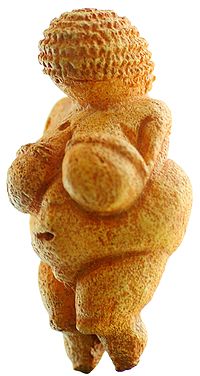Venus of Willendorf
From Wikipedia, the free encyclopedia
| Venus of Willendorf | |
 |
|
| Material | Oolitic limestone |
|---|---|
| Created | 24,000 BC – 22,000 BC |
| Discovered | 1908 near Willendorf, by Josef Szombathy |
| Present location | Naturhistorisches Museum, Vienna, Austria |
The Venus of Willendorf, also known as the Woman of Willendorf, is an 11.1 cm (4 3/8 inches) high statuette of a female figure estimated to have been created between 24,000 BCE – 22,000 BCE. It was discovered in 1908 by archaeologist Josef Szombathy at a paleolithic site near Willendorf, a village in Lower Austria near the city of Krems.[1] It is carved from an oolitic limestone that is not local to the area, and tinted with red ochre.
Since this figure's discovery and naming, several similar statuettes and other forms of art have been discovered. They are collectively referred to as Venus figurines, although they pre-date the mythological figure of Venus by millennia.
Contents |
[edit] History
As of 1990, following a revised analysis of the stratigraphy of its site, it has been estimated to have been carved 24,000–22,000 BC.[1] Very little is known about its origin, method of creation, or cultural significance.
The Venus is not a realistic portrayal but rather an idealization of the female figure. Her vulva, breasts, and swollen belly, are heavily pronounced, suggesting a strong connection to fertility. Her tiny arms are folded over her breasts. The figure has no visible face, her head being covered with circular horizontal bands of what might be rows of plaited hair, or a type of headdress.[2]
The nickname, urging a comparison to the classical image of "Venus," causes resistance in some modern analyses. According to Christopher Witcombe, "the ironic identification of these figurines as 'Venus' pleasantly satisfied certain assumptions at the time about the primitive, about women, and about taste".[3]
The purpose of the carving is subject to much speculation. The statue's feet do not allow it to stand on its own. Due to this it has been speculated that it was meant to be picked up, rather than simply looked at.
Catherine McCoid and LeRoy McDermott hypothesize that the figurines may have been created as self-portraits.[4] Other theorists believe that the head, seen from a profile view, while having no distinct facial features, appears to be looking down. The common physical characteristics of the Venus figures are: a thin upper torso, greatly exaggerated breasts, large buttocks and thighs, a large belly (possibly due to pregnancy), and oddly bent, short legs, that end with disproportionately small feet. Yet when thought of as a woman looking down at her own body, the physical features, in perspective, seem correct. There are striking similarities between such figurines and a pregnant woman when perceived from above.
Stephen R. Berlant has suggested a possible connection with a mushroom cult, based on visual similarities between the figurine and typical young Amanita muscaria mushrooms.[5]
Venus of Willendorf is part of the collection of the Naturhistorisches Museum in Vienna.[6]
[edit] Notes
- ^ a b Venus of Willendorf Christopher L. C. E. Witcombe, 2003.
- ^ "Woman from Willendorf". Christopher L. C. E. Witcombe. 2003. "The rows are not one continuous spiral but are, in fact, composed in seven concentric horizontal bands that encircle the head."
- ^ "Name". Christopher L. C. E. Witcombe, 2003.
- ^ McDermott, LeRoy. "Self-Representation in Upper Paleolithic Female Figurines". Current Anthropology, Vol. 37, No. 2, April., 1996. pp. 227-275.
- ^ Stephen R. Berlant, "The Prehistoric Practice of Personifying Psychotropic Mushrooms". The Journal of Prehistoric Religion, Vol. XIII, 1999, pp. 22-29.
- ^ Witcombe, Christopher. Venus of Willendorf. Retrieved on January 18, 2008.
[edit] See also
[edit] External links
| Wikimedia Commons has media related to: Venus of Willendorf |
- Christopher L. C. E. Witcombe, "Women in Prehistory:Venus of Willendorf".
- Venus figures from the Stone Age - The Venus of Willendorf, Don's Maps
- The Invisible Sex: Uncovering the True Roles of Women in Prehistory by J.M. Adovasio, Olga Soffer and Jake Page, ISBN 9780061170911, gives a new 'view' of headdress as possible model for weaving a basket; Laura Miller review at Salon.com: [1]
- The Origin and Significance of Anthropomorphic Goddess Figurines with Particular Emphasis on The Venus of Willendorf, Stephen R. Berlant (an extended version of the article mentioned in the notes, from the Internet Archive, most images not working)


